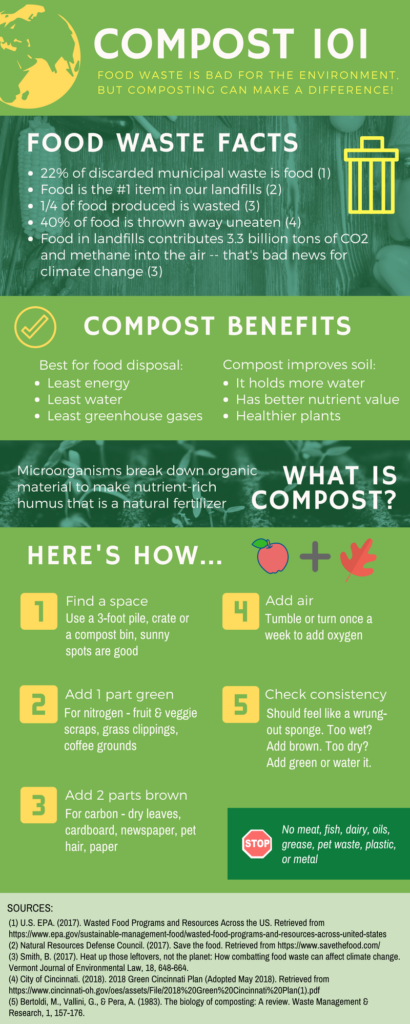I have a confession to make—my family wastes food.
We have the best-laid plans to prepare fresh meals, but the fridge sucks those strawberries to the back and hides them until they become a science experiment. My kids turn up their noses at leftovers and pick through their food. Every time I clean out the fridge and scrape off the dinner plates, I feel guilty! I can’t be the only one, can I?

Turns out, I’m not. In the Cincinnati area, 130,000 tons of food are thrown out each year, and an average family throws out $1,400 worth of food. So, there’s wasted money. (Yikes!) Plus, the fact that while I’m throwing out food, thousands of people don’t know where their next meal is coming from. (Double yikes!) On top of that, wasted food is actually a huge environmental concern. About 22% of municipal waste is food which then rots in landfills creating greenhouse gases, to the tune of 3.3 billion tons, that add to climate change concerns. (Triple yikes!)
This past summer, one of my grad school classes lit a fire under me to make a change. First, I tracked our family’s food use for two weeks. During that period, we threw out about 384 ounces of food at a cost of $45.14 (that would be just under $1,200 for the year). Then, we made a change!
It started with buying a little less at the store, freezing produce before it went bad (great for smoothies!), and getting leftovers to the freezer if they wouldn’t be eaten right away. But, let’s be honest. I’ve got kids, so I’m always going to have food they don’t eat. Plus, what about all those banana peels and apple cores?
We turned to composting to help out! I’d always been interested in it, but it seemed too confusing, difficult, and smelly! The reality is, backyard composting is the most environmentally-friendly way to deal with food waste, and you end up with great soil for your garden. All you need is space, waste and some air.
Here’s the breakdown:
- Find your space. Use a 3-foot pile, crate or compost bin. We purchased a closed, tumbling bin just to make it easier.
- Add “green” materials. These are nitrogen-rich items like fruits and vegetables or grass clippings.
- Add “brown” materials. These are carbon-rich items like dry leaves, cardboard, newspaper, and even pet hair. You need about twice as much brown material and always want to cover a layer of green with a layer of brown.
- Add air. Turn the pile or tumble it once a week to let air in.
- Check the consistency. It should be like a wrung-out sponge. If it’s too wet, just add more brown. Too dry? Just add green or some water.
I added a collection container on our kitchen counter to grab food scraps. (My kids actually fight over who gets to take it out and spin the composter in the backyard!) Our new compost habit saved us money and can help the environment. After tracking food for another two weeks, we found that we cut our waste by 78%, and none of it went into the garbage. Over the course of a year, our new compost habit would save the greenhouse gas equivalent of 51 days of electricity!
Side note: I kept Googling to see what I could add to the pile, so as part of my grad school work, I created an app that identifies the green and brown items you can add, and the things you should steer clear of. You can download it using this link if you’re interested in a quick reference to help you on your composting journey.






 Shara Clark, APR, works to balance life as a wife, mom to two sons, professor, and grad student. With more than 20 years of experience in public relations, she currently teaches strategic communications at Miami University while also working to complete a master’s degree through Miami’s Project Dragonfly program. Most days you can find her at her computer, working with students, trying to squeeze in a walk at the park, or cheering on her kids at various sporting events. In her free time, she… wait, there’s no such thing as free time!
Shara Clark, APR, works to balance life as a wife, mom to two sons, professor, and grad student. With more than 20 years of experience in public relations, she currently teaches strategic communications at Miami University while also working to complete a master’s degree through Miami’s Project Dragonfly program. Most days you can find her at her computer, working with students, trying to squeeze in a walk at the park, or cheering on her kids at various sporting events. In her free time, she… wait, there’s no such thing as free time!







This is a great resource to get people interested in composting their food waste and reducing their carbon footprint! It’s nice to see fellow Dragonflies making real changes in the world. I do have one correction: hair (both pet and people) is actually a green (nitrogen) source, and not a brown (carbon) source. If you’re only adding a little bit, it shouldn’t throw off your composting process too much, but in large amounts, it has the potential to turn things anaerobic and smelly!